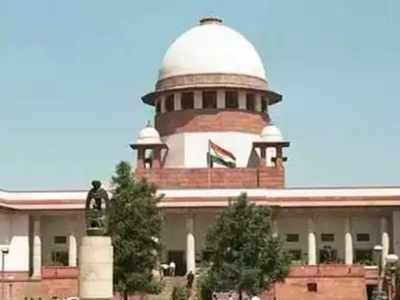- News
- India News
- In a first, virtual court goes completely paperless in SC
Trending
This story is from June 2, 2020
In a first, virtual court goes completely paperless in SC

NEW DELHI: In a pioneering development for a three crore case file ridden judiciary consuming a staggering 10 billion sheets of paper annually, a virtual court of the Supreme Court went paperless on Monday and judges heard cases without having a single paper-book case file on their table.
It was an unusual sight in virtual court number 3. Missing were the usually stacked up case files besides the three chairs on the dais prior to assembling of the Judges in the courtroom.Even more unusual sight was the walking in of three judges - Justices D Y Chandrachud, Hemant Gupta and Ajay Rastogi - with their laptops. They opened the laptops and started hearing the cases by looking into their laptops even as most lawyers connected through video links were seen using paper case files.
During the arguments, the judges were seen making notes on the laptop itself as the hearings continued without any glitch. If all judges in the Supreme Court, High Court and trial courts follow suit, then the judiciary will be saving 10 billion sheets of paper and thousands of trees from being felled for the purpose every year.
The first move to make the SC proceedings paperless was initiated by then CJI J S Khehar, who in 2017 brought in large-screened computers which were placed before the Judges in the first five courts. But, the Judges who had worked with case files and physically turned pages to go through the petitions, were at odds with the sudden decision to go paperless. "I will rather reads the files physically than go through it in computer. It just does not feel that one has read a file when reads a petition on computer screen," a Judge had said three years back.
To give technology a boost to streamlining filing of cases and their categorisation for grouping, SC's E-Committee, headed by Justice Chandrachud, has constituted a committee to prepare a standard operating procedure for digitisation and e-filing of cases in all High Court and district courts. "The e-filing module is ready for the district courts and the HCs," the sources said.
Many judges in different HCs told TOI that the technology given for virtual hearing does not support simultaneous functioning of more than three virtual courts impeding the HC from listing large number of cases daily. The E-Committee sources said, "Bandwidth was a problem as NIC, which is the facilitator, is overloaded with huge government-related work. But, that problem has been solved now as NIC has acquired several dedicated serves exclusively for courts. So, the HCs can now expand the number of virtual courts now."
It was an unusual sight in virtual court number 3. Missing were the usually stacked up case files besides the three chairs on the dais prior to assembling of the Judges in the courtroom.Even more unusual sight was the walking in of three judges - Justices D Y Chandrachud, Hemant Gupta and Ajay Rastogi - with their laptops. They opened the laptops and started hearing the cases by looking into their laptops even as most lawyers connected through video links were seen using paper case files.
During the arguments, the judges were seen making notes on the laptop itself as the hearings continued without any glitch. If all judges in the Supreme Court, High Court and trial courts follow suit, then the judiciary will be saving 10 billion sheets of paper and thousands of trees from being felled for the purpose every year.
The first move to make the SC proceedings paperless was initiated by then CJI J S Khehar, who in 2017 brought in large-screened computers which were placed before the Judges in the first five courts. But, the Judges who had worked with case files and physically turned pages to go through the petitions, were at odds with the sudden decision to go paperless. "I will rather reads the files physically than go through it in computer. It just does not feel that one has read a file when reads a petition on computer screen," a Judge had said three years back.
Most judges shared the view. Soon, the huge computers were folded and used as table tops. Later, these were removed from courtrooms to storerooms. "Software for court-work at that time was not advanced and had several shortcomings. Present software is much more advanced. It allows the Judges to make notes with special pens on the computer screen itself about a case and these notes can be preserved confidentially. The law clerks' notes as well as the Judge's own noting can be stored separately and could be seen by the Judge during the hearing along with the case file," sources said.
To give technology a boost to streamlining filing of cases and their categorisation for grouping, SC's E-Committee, headed by Justice Chandrachud, has constituted a committee to prepare a standard operating procedure for digitisation and e-filing of cases in all High Court and district courts. "The e-filing module is ready for the district courts and the HCs," the sources said.
Many judges in different HCs told TOI that the technology given for virtual hearing does not support simultaneous functioning of more than three virtual courts impeding the HC from listing large number of cases daily. The E-Committee sources said, "Bandwidth was a problem as NIC, which is the facilitator, is overloaded with huge government-related work. But, that problem has been solved now as NIC has acquired several dedicated serves exclusively for courts. So, the HCs can now expand the number of virtual courts now."
End of Article
FOLLOW US ON SOCIAL MEDIA










